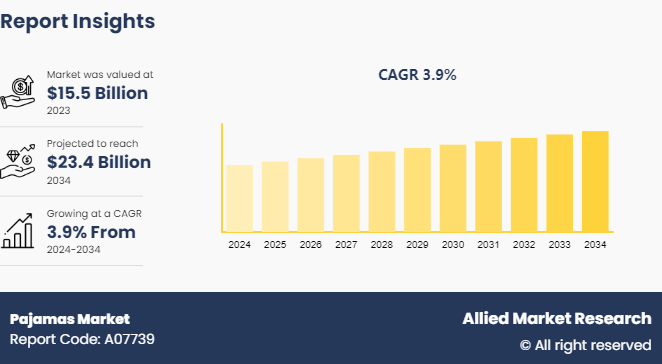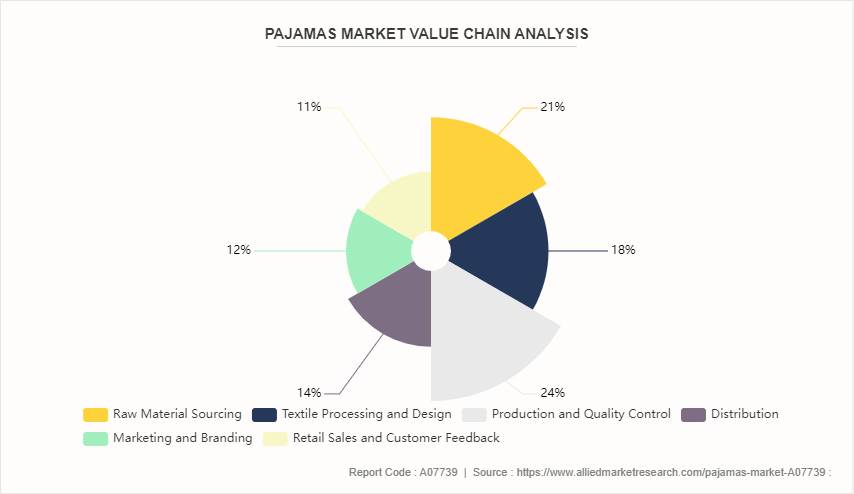Pajamas Market Research, 2034
Market Introduction and Definition
The global pajamas market size was valued at $15.5 billion in 2023, and is projected to reach $23.4 billion by 2034, growing at a CAGR of 3.9% from 2024 to 2034. Pajamas are comfortable clothing designed for sleeping or lounging, typically consisting of a loose-fitting top and bottom. They are available in various styles, such as button-up shirts, pullovers, nightgowns, and onesies, catering to different preferences and needs. Pajamas are made from diverse materials, including cotton, silk, flannel, and blends, providing varying levels of warmth and comfort depending on the season and personal choice. Besides their practical use for sleep, pajamas have also become a fashion statement, with many designs featuring unique prints, patterns, and motifs that reflect individual tastes. This versatility has made pajamas popular for both nightwear and casual lounging around the home, offering comfort and style to suit any mood or occasion. Pajamas often incorporate elements that add to comfort, such as elastic waistbands and soft fabrics.

Key Takeaways
The pajamas market study covers 20 countries. The research includes a segment analysis of each country in terms of value ($Billion) for the projected period 2024-2034.
More than 1, 500 product literatures, industry releases, annual reports, and other such documents of pajamas industry participants along with authentic industry journals, trade associations' releases, and government websites have been reviewed for generating high-value industry insights.
The study integrated high-quality data, professional opinions and analysis, and critical independent perspectives. The research approach is intended to provide a balanced view of global markets and to assist stakeholders in making educated decisions in order to achieve their most ambitious growth objectives.
Key Market Dynamics
The rise in demand for comfortable sleepwear has significantly boosted the global pajamas market. As more people prioritize comfort and relaxation at home, particularly after the lifestyle shifts caused by the COVID-19 pandemic, there has been an increase in the purchase of pajamas that offer both style and comfort. Consumers are seeking pajamas made from soft, breathable materials that enhance sleep quality, driving manufacturers to innovate in fabric technology and design. The trend toward remote work and spending more time at home has further driven this demand, with many individuals opting for pajamas that can double as loungewear. The surge in demand has led to expanded product lines, which has increased the sales through e-commerce platforms, and a rise in competition among brands aiming to capture the growing pajamas market share.
Moreover, the influence of social media on fashion trends has surged demand in the pajamas market by strengthening the visibility of fashionable sleepwear. Platforms such as Instagram and TikTok feature influencers and celebrities wearing stylish pajamas, which drives consumer interest and encourages imitation of these trends. Social media also allows for immediate access to new styles and direct purchasing options, speeding up buying decisions. The increased visibility of sleepwear trends has led consumers to seek out a variety of stylish and comfortable pajamas, prompting brands to innovate and cater to the growing demand for on-trend, comfortable pajama products.
However, fluctuations in raw material prices have restrained demand in the pajamas market by increasing production costs. Variability in the costs of essential materials such as cotton, polyester, and elastane can lead to higher prices for finished pajamas, which has them less affordable for certain consumers. The increase in cost often forces manufacturers to raise retail prices, which can deter price-sensitive buyers and slow down sales. In addition, unpredictability in material costs can disrupt supply chains and lead to shortages or delays, further impacting market availability. Consequently, these price fluctuations can dampen consumer enthusiasm and limit overall pajamas market growth by making pajamas less accessible to a broader audience.
Furthermore, the growing interest in luxury sleepwear has created significant opportunities in the pajamas market by driving demand for high-quality, premium products. Consumers increasingly seek out luxurious sleepwear made from fine materials such as silk, high-thread-count cotton, and cashmere, reflecting a broader trend toward investing in comfort and self-care. The shift has prompted brands to develop exclusive collections that offer superior craftsmanship, stylish designs, and enhanced comfort. Moreover, the rise in emphasis on personalized and high-end sleep experiences has encouraged manufacturers to innovate and cater to the luxury pajamas segment, resulting in a diverse range of upscale pajamas. Thus, the luxury sleepwear trend has led to new market segments and growth opportunities for premium pajama offerings, thus driving the global pajamas market demand.
Value Chain Analysis of Global Pajamas Market

The value chain of the pajamas market begins with raw material sourcing, including fabrics such as cotton, polyester, and silk. Manufacturers then process these materials into textiles, which are designed and cut into pajama patterns. Production involves sewing and finishing, where quality control ensures the final product meets standards. Next, finished pajamas are distributed through various channels, including retail stores, e-commerce platforms, and specialty boutiques. Marketing and branding efforts promote the pajamas, highlighting features and styles to attract consumers. Finally, retail sales and customer feedback loop back to influence future designs and production strategies. Throughout the chain, each stage adds value, from material selection to consumer purchase, driving growth and innovation in the market.
Market Segmentation
The global pajamas market is segmented into product type, material, end user, distribution channel, and region. On the basis of product type, the market is categorized into casual pajamas, and luxury pajamas. As per material, the market is classified into cotton, silk, flannel, and others. On the basis of end user, the market is divided into men, women, and children. According to distribution channel, it is fragmented into supermarkets/hypermarkets, specialty stores, departmental stores, online sales channel, and others. Region wise, the pajamas market is analyzed across North America, Europe, Asia-Pacific, and LAMEA.
Regional/Country Market Outlook
High demand for pajamas in the U.S. arises from increased emphasis on comfort and self-care, with consumers prioritizing relaxation and quality sleep. The rise of remote work and more time spent at home has also boosted pajama sales as people seek cozy, versatile clothing for lounging and sleeping. Current trends include the popularity of matching pajama sets, often with playful or stylish patterns, which cater to both comfort and fashion. Additionally, sustainable and eco-friendly materials are gaining traction as consumers become more environmentally conscious. Moreover, personalized and monogrammed pajamas are also trending in the U.S., which reflects a desire for unique, customized sleepwear.
The Asia-Pacific region holds significant growth potential for the pajamas market owing to rise in disposable incomes, urbanization, and increase in focus on comfort and wellness. Countries such as China and India are expected to experience high sales growth driven by the growing populations and expanding middle class. In China, the demand is fueled by an increasing emphasis on home comfort and quality sleep, while market growth in India is supported by change in lifestyle preferences and rise in living standards. Furthermore, Japan and South Korea have experienced a boost in luxury and fashionable sleepwear segments owing to the trend-sensitive consumers in the country along with higher spending power. The diverse and expanding market in these countries presents ample opportunities for brands to capture a larger pajamas market share of the growing consumer base.
Industry Trends:
Seasonal and holiday-themed designs have significantly influenced global pajamas market trends by driving consumer enthusiasm and boosting sales during specific times of the year. These designs, featuring festive patterns and colors related to holidays such as Christmas, Halloween, and Valentine’s Day, create a sense of occasion and celebration, which encourages consumers to purchase matching or themed pajamas for themselves and their families. Retailers often introduce limited-edition collections and promotional campaigns to generate excitement and urgency. The popularity of seasonal designs also enhances brand visibility and customer loyalty, as consumers anticipate seasonal releases and holiday-themed offerings each year, thus boosting the pajamas market size.
In addition, consumers are increasingly inclined toward matching pajama sets due to their visual appeal and the sense of coordination and comfort they provide. These sets, which feature complementary designs and colors, create a cohesive and stylish look that attracts those seeking both aesthetics and uniformity in their sleepwear. The trend has become popular for family and couple sleepwear, especially during holidays and special occasions, enhancing a sense of togetherness. The growing preference for matching pajama sets has influenced the global pajamas market, prompting brands to expand their offerings with a variety of coordinated styles and fabrics. Thus, the shift has driven market growth as consumers prioritize both fashion and functionality in their sleepwear.
Competitive Landscape
The major players operating in the pajamas market include Victoria's Secret, Hanesbrands Inc., Ralph Lauren Corporation, Calvin Klein, Gap Inc., L.L.Bean, Soma Intimates, Marks & Spencer, Jockey International, Inc., and Tommy Hilfiger.
Other players in the pajamas market include H&M, Joules Limited, Zara, PajamaGram, Carhartt, Inc., Eileen Fisher, Sleep Number Corporation, Hugo Boss, La Perla, and so on.
Recent Key Strategies and Developments
In November 2021, Fashion designer Masaba Gupta collaborated with Nykaa Fashion to introduce a new line of sleepwear under the Nykd private label. This line was designed to reflect the House of Masaba brand's evolution while offering women comfort and style.
In June 2021, Cozyland, a line of eco-friendly, gender-neutral sleepwear, was introduced by Morgan Lane. The sleepwear is available for both adults and kids and is made from GOTS-certified cloud-soft fabric.
In February 2021, Canadian sleepwear company Maylyn & Co. launched vegan sleepwear, focusing on sustainable and luxurious options. The pajamas are made from Persian Lotus silk, a breathable vegan alternative to traditional silk, which helps reduce nighttime perspiration.
Key Benefits For Stakeholders
- This report provides a quantitative analysis of the market segments, current trends, estimations, and dynamics of the pajamas market analysis from 2025 to 2034 to identify the prevailing pajamas market opportunities.
- The market research is offered along with information related to key drivers, restraints, and opportunities.
- Porter's five forces analysis highlights the potency of buyers and suppliers to enable stakeholders make profit-oriented business decisions and strengthen their supplier-buyer network.
- In-depth analysis of the pajamas market segmentation assists to determine the prevailing market opportunities.
- Major countries in each region are mapped according to their revenue contribution to the global market.
- Market player positioning facilitates benchmarking and provides a clear understanding of the present position of the market players.
- The report includes the analysis of the regional as well as global pajamas market trends, key players, market segments, application areas, and market growth strategies.
Pajamas Market Report Highlights
| Aspects | Details |
| Market Size By 2034 | USD 23.4 Billion |
| Growth Rate | CAGR of 3.9% |
| Forecast period | 2024 - 2034 |
| Report Pages | 290 |
| By Product Type |
|
| By Material |
|
| By End User |
|
| By Distribution Channel |
|
| By Region |
|
| Key Market Players | Calvin Klein, soma intimates, Tommy Hilfiger Corporation, Gap Inc., Hanesbrands Inc., Jockey International, Inc., Victoria's Secret & Co., Marks & Spencer, L.L. Bean, Ralph Lauren Corporation |
Emerging trends include sustainable fabrics, gender-neutral designs, multifunctional sleepwear, digital customization, and increased demand for premium, comfortable pajamas.
The leading application of the pajamas market is loungewear, driven by the increasing demand for comfortable and versatile clothing for home use.
Based on region, North America held the highest market share in terms of revenue in 2023.
The global pajamas market was valued at $15.5 billion in 2023.
The major players operating in the pajamas market include Victoria's Secret, Hanesbrands Inc., Ralph Lauren Corporation, Calvin Klein, Gap Inc., L.L.Bean, Soma Intimates, Marks & Spencer, Jockey International, Inc., and Tommy Hilfiger.
Loading Table Of Content...


